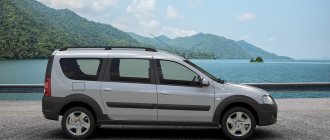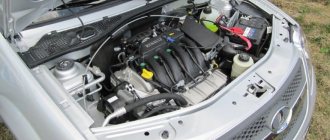February 17, 2015 Lada.Online 430 834 31
Depending on the year of manufacture, the Largus may be equipped with a Renault or VAZ engine. Currently, only domestic engines are installed on this car. Let's take a closer look at the technical characteristics of Lada Largus engines, as well as the features of their assembly.
- Renault-Nissan K7M
(8 valves) with a volume of 1.6 liters is capable of developing a power of 84 hp. This motor is installed on the “standard” and “norm” configurations. - Renault-Nissan K4M
(16 valves) is slightly more powerful, also 1.6 liters, but has a power of 105 hp. or 77 kW. The motor is provided for the “luxury” configuration. - VAZ 11189
(1.6 liter, 87 hp, 8 valves) began to be installed instead of K7M in 2015. - VAZ 21129
(1.6 liter, 106 hp, 16 valves) began to be installed instead of Renault K4M in October 2021. - VAZ 11182
(1.6l., 90hp, 8kl) began to be installed on Largus FL from March 2021
Both are Renault Alliance engines. Since December 2015, AVTOVAZ began installing its 8-valve VAZ-11189 engine. You can get acquainted with its pros and cons from this review.
Both engines from Renault-Nissan are paired with a 5-speed manual transmission. At the moment, AVTOVAZ does not plan to equip the Lada Largus with an automatic transmission.
Lada Largus engines are distinguished by high elasticity, and the manual gearbox is distinguished by precise gear shifting. For dynamic acceleration and confident overtaking, the engine power is quite enough. Both Lada Largus engines comply with Euro 4 environmental requirements.
Depending on the vehicle configuration, there are several options for installing auxiliary equipment on the engine:
- car with non-power steering;
- car without power steering with air conditioning;
- vehicle with hydraulic power steering;
- car with hydraulic power steering and air conditioning.
Technical characteristics of Renault engines
| Options | Engine model | |
| RENAULT, K4M | RENAULT, K7M | |
| Injection type | Electronically controlled multipoint fuel injection | |
| Fuel type | Gasoline Premium-95 GOST 51105-97 | |
| Number and arrangement of cylinders | 4, in-line | |
| Number of valves | 16 | 8 |
| Cylinder operating order | 1-3-4-2 | |
| Direction of rotation of the crankshaft (camshaft drive side) | ||
| right | ||
| Cylinder diameter/piston stroke, mm | 79,5×80,5 | |
| Working volume, cm3 | 1598 | |
| Compression ratio | 9,8 | 9,5 |
| Toxicity standards | Euro 4 | |
| Power at 5500 rpm, kW (hp) | — | 62 (84) |
| Power at 5750 rpm, kW (hp) | 77 (105) | — |
| Maximum torque, N.m (at rpm) | 148 (3750) | 124 (3000) |
| Volume of oil poured into the engine lubrication system, including oil filter, l | 4,8 | 3,3 |
Description of the K7M engine (Renault Logan/Sandero/Largus)
In 2010, the K7M 800 engine appeared, which replaced the K7M 710. No design changes occurred, except that the engine was strangled, bringing it up to the Euro-4 environmental standard, while the power decreased from 86 hp to 83 hp. With.
The disadvantages of the engine remain the same:
- high fuel consumption.
- At idle the speed often fluctuates.
- Every 20-30 thousand km the valves need to be adjusted.
- no hydraulic compensators.
- If the belt breaks, the valve bends; it is recommended to change the belt every 60 thousand km.
- crankshaft oil seal leaking.
- the engine is noisy.
- there are vibrations during operation.
If you look at the engine from the positive side, it is worth noting its high reliability; according to the passport, the engine life is about 400 thousand km, but in practice it is a little more.
Motors and gearboxes "Lada Largus"
At the start of sales, Largus received reliable engines from Renault: a 1.6-liter with 84 hp. With. and 105 l. With. And although the engines were in no hurry to boast of efficiency (14 l/100 km) or even a hint of dynamics (acceleration to “hundreds” takes 14 seconds), with good maintenance they “ran” up to 400 thousand km! But in 2021, at the plant in Tolyatti they decided that French engines in a domestic car were expensive, impractical and generally bad manners, and began installing Russian engines on the Largus.
Our country cannot yet boast of achievements in the field of automotive industry, so the target audience did not accept engines from Vesta and Grants with joy. New engines are a little more economical (11 l/100 km) and more dynamic (12 seconds to “hundred”), but they do not have the same reliability. The resource has decreased to 200 thousand km, regular minor breakdowns have replaced problem-free operation.
Read also: Why does the muffler slam?
Buyers did not have a choice of gearbox: all versions were equipped with a manual transmission. The box does not require special attention and lasts a long time. It is filled with oil for its entire service life, according to the manufacturer, but experts recommend changing it at least every 100 thousand km.
French gearboxes, which were installed with Renault engines, annoyed drivers with increased speed in fifth gear. Already at 90 km/h the speed was about three thousand, and at a speed of 110-130 km/h the engine howled at four thousand revolutions. Even the music couldn’t drown out the roar of the engine, and fuel consumption increased with every kilometer. This disease is treated by removing the box cover and replacing the fifth gear gears. The boxes that were installed with domestic engines no longer suffered from this problem.
Description of the K4M engine (Renault Logan/Sandero/Largus)
It is a development of the K7M series, with a new cylinder head, already 16 valve. There are many differences: K4M is quieter, it is more economical, there are no vibrations and many other advantages.
Motor disadvantages:
- expensive spare parts.
- If the belt breaks, the valve bends; it is recommended to change the belt every 60 thousand km.
- there are failures in work.
- Low-quality fuel causes the revs to fluctuate.
- troit (most often the problem is in the ignition coil, injectors or spark plugs).
- Unstable operation and floating speed are usually caused by the crankshaft position sensor or ignition coil.
If you choose between K7M and K4M, then the choice should definitely remain with the more modern and practical K4M.
Whose engine is Lada Largus
Previously, engines for Lada Largus came assembled from the Renault plant in Spain, but recently engines of the K4M series (16 valves, 105 hp) began to be assembled at AVTOVAZ. According to the director of the Power Units project, Francois Goujon, the quality of engines assembled at AVTOVAZ corresponds to the world level.
The AVTOVAZ press service assures that a quality system is used in the production of new engines to ensure that products comply with the international standards of the alliance. In addition to personnel training, it includes control on the production line, during which each assembled engine is tested in different modes on a special stand. The technology also provides for a weekly check, when one of the motors is completely disassembled and the quality of its assembly is analyzed.
Lada Largus
Largus with a 16-valve K4M engine producing 105 hp. was more popular than the version with the 84-horsepower eight-valve K7M engine of Romanian production, which was frankly rather weak. Why "was"? But because the transition to Euro 5 was a death sentence: driving this engine into new standards means coming to terms with the inevitable loss of power and torque, and it’s not a hero anyway. In addition, it is not produced at AVTOVAZ - therefore, it falls into the category of foreign currency components.
An elegant move was found, and for rubles: under the hood, VAZ’s original VAZ-1118 eight-valve engine was registered. A Largus with such an engine costs from 497,500 rubles for a van and from 524,500 rubles for a station wagon.
Read also: Conversion of a pvc boat trailer
The engine was given its own index, VAZ‑11189, since the supports and the entire set of attachments (power steering pump, generator, air conditioning compressor) were changed. But the essence is still the same: this engine with a lightweight connecting rod and piston group is well known to owners of front-wheel drive Ladas and Datsuns as a reliable and easy-to-maintain unit.
What did you get regarding the foreign K7M engine? Power 87 “horses” (+3 hp), maximum torque 140 Nm (+17 Nm). The maximum speed of the five-seater station wagon increased by 2 km/h, the van and seven-seater station wagon by 3 km/h. The five-seater Largus accelerates to hundreds by three tenths of a second, the seven-seater by a second.
Another advantage: the French engine requires AI-95 gasoline, while ours is officially allowed 92. Fuel consumption in the service documents is indicated as before, but I dare to assume that in real life the VAZ engine will be less voracious.
To install the VAZ-11189 engine on the Largus, a rearrangement was required: the battery was moved, the fuse box was changed, and the coolant expansion tank was moved to the right wing. In its place is now an air filter housing from Vesta. The air intake resonator is, of course, also a new model. Hoses, lines, and electrical wiring harnesses are laid differently.
Paired with the new engine is a 5-speed JR5 gearbox, designed for torque up to 200 Nm. It is familiar from the cars of the Renault-Nissan alliance - it is installed, for example, on the Sandero Stepway. The gearbox is adapted for the Russian engine: gear pairs with different gear ratios are selected. The drive of the switching mechanism is cable. But the clutch is controlled by hydraulics.
In addition, the car received a new clutch housing, common with the XRAY model, as well as a driven disc and LuK basket.
About the domestic VAZ 11189 engine
In April 2021, AVTOVAZ began installing domestic VAZ 11189 engines on Largus. The advantages of this engine are described in one of the issues of “Okay Mechanics”.
| Some measurement results Autoreview | |||
| Options | Cars | ||
| Lada Largus (VAZ engine) | Lada Largus (Renault engine) | ||
| Maximum speed, km/h | 157,1/156,7* | 168,0/167,6 | |
| Acceleration time, s | 0—50 km/h | 4,3/4,8 | 3,9/4,4 |
| 0—100 km/h | 13,9/16,8 | 12,5/14,5 | |
| 0—150 km/h | 61,1/71,6 | 38,9/43,7 | |
| on the way 400 m | 19,3/20,2 | 18,4/19,4 | |
| on the way 1000 m | 36,1/37,8 | 34,1/36,0 | |
| 60-100 km/h (III) | 8,7/10,6 | 9,3/10,6 | |
| 60-100 km/h (IV) | 12,1/15,1 | 12,8/14,1 | |
| 80-120 km/h (V) | 19,3/24,0 | 22,1/23,4 | |
| * Partial load/full load | |||
| Engine characteristics | ||
| Options | VAZ-11189 | Renault K4M |
| Volume, cm3 | 1596 | 1598 |
| Number of valves | 8 | 16 |
| Maximum power, hp/kW/rpm | 87/64/5100 | 102/75/5750 |
| Maximum torque, Nm/rpm | 140/3800 | 145/3750 |
| Cylinder diameter/piston stroke, mm | 82,0/ 75,6 | 79,5/80,5 |
| Compression ratio | 10,3:1 | 9,8:1 |
| Injection type | distributed, electronically controlled | |
| Octane number of gasoline | at least 92 | not less than 95 |
New VAZ 11182 engine
At the beginning of 2021, AVTOVAZ introduced a new 8-valve 1.6-liter engine (VAZ 11182 or AR16SEg2), which first appeared on the Lada Largus FL and will later appear on the Lada Granta FL.
AVTOVAZ writes that the new engine featured an updated connecting rod and piston group, a modernized crankshaft and a gas distribution mechanism. As a result, power is increased to 90 hp, and 80% of torque is available from 1000 rpm, which reduces fuel consumption and reduces shift frequency. In addition, the need to adjust valves before a mileage of 90,000 kilometers is eliminated. The engine is adapted to run on gasoline with an octane rating of 92. Read more about the design in this review. Technical characteristics and reviews about it are at the link.
Let us remind you that you can read about the VAZ 21129 engine here.
Key words: Lada Largus engine
+23
Share on social networks:
Found an error? Select it and press Ctrl+Enter..
What is the reason for its popularity: the advantages of Lada Largus
There is no need to judge the appearance of the Largus: the current station wagon is a copy of the Dacia Duster MCV, originally from the early 2000s. AvtoVAZ designers did not bother to change the appearance of the model, but this did not scare off the target audience: practical drivers do not put design at the forefront.
The main trump cards of the domestic “heel” are capacity and price. From a car with a spacious trunk of more than 600 liters, the interior is transformed into a seven-seater car. And with two rows of seats folded, a fifth dimension opens up, containing almost 2.5 thousand liters of cargo! At the same time, the third row of seats is by no means just for show, like many crossovers.
Not only legless dwarfs, tiny animals or children will be able to sit comfortably in the last row. Even two adults of standard build and height can survive a long trip there, because a seven-seater cabin is needed not only by large families, but also by those who have many friends. And thanks to the rectangular shape of the body and interior trim without bevels, it is easy to carry long items in the trunk: boards, building materials, oversized cargo, etc. Practicality is the Largus’s ace in the hole.
Low cost is the second plus of the model. Maintenance costs are also low and spare parts are easy to find. Simple optics and a primitive design in this case play into the hands of the model. No matter how much journalists talk about how “Lada rises from its knees,” Togliatti has not yet learned how to assemble reliable automatic transmissions, let alone more complex and smart designs. Therefore, the simpler, the more reliable and cheaper.
Read also: Motor oil m10g2k application
Another advantage of the model is its ground clearance. For the regular version of LADA Largus it reaches 170 mm, for the cross version - 200 mm.











